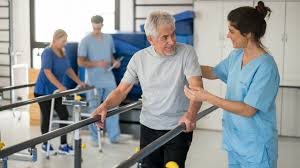Physical rehabilitation centers play a crucial role in helping Rehabilitation Center in Muscat individuals recover from injuries, surgeries, chronic conditions, or disabilities. These centers offer a wide range of treatments tailored to meet each patient’s specific needs, focusing on restoring mobility, strength, and overall quality of life. In this article, we’ll explore three main types of treatment commonly offered at physical rehabilitation centers and how they can benefit individuals on their road to recovery.
Physical Therapy
Physical therapy is one of the most common treatments offered at rehabilitation centers. It focuses on improving movement, relieving pain, and strengthening the muscles and joints to enhance physical function. Physical therapy is often recommended for individuals recovering from sports injuries, orthopedic surgeries, stroke, or conditions like arthritis and back pain.
Key Components of Physical Therapy
- Exercise Therapy: Customized exercises are designed to improve strength, flexibility, and balance. These exercises may include stretching, strength training, balance exercises, and low-impact aerobic exercises.
- Manual Therapy: Therapists use hands-on techniques to manipulate muscles and joints, which can help alleviate pain, reduce stiffness, and improve mobility. Techniques may include massage, joint mobilization, and soft tissue manipulation.
- Pain Management: Physical therapists use a variety of techniques, such as heat and cold therapy, ultrasound, and electrical stimulation, to manage pain and reduce inflammation in injured or sore areas.
- Education and Home Exercises: Physical therapists often provide education on body mechanics, posture, and ergonomics to prevent re-injury. Patients may also receive a set of exercises to perform at home to support ongoing recovery.
Benefits of Physical Therapy
Physical therapy helps individuals regain physical function, reduce pain, and prevent future injuries. By strengthening muscles and improving flexibility, patients can often return to daily activities with greater ease and confidence Indoor Business Signs Charlotte NC Archives – Anderson Finance Hub.
Occupational Therapy
Occupational therapy (OT) is designed to help patients regain the ability to perform daily activities and improve their quality of life. Unlike physical therapy, which focuses on restoring movement and strength, occupational therapy emphasizes the practical skills needed for independence and self-care How to Use a Turbo Vape Effectively: A Comprehensive Guide.
Key Components of Occupational Therapy
- Self-Care Training: Occupational therapists assist patients in relearning essential daily tasks, such as dressing, bathing, cooking, and eating, especially if these abilities have been impacted by an injury, surgery, or illness.
- Adaptive Equipment Training: OT professionals may introduce patients to adaptive tools and devices, such as reachers, grab bars, and modified utensils, to enhance their independence in everyday tasks.
- Cognitive Rehabilitation: For patients who have experienced brain injuries or strokes, occupational therapy may include cognitive exercises to improve memory, attention, problem-solving skills, and decision-making abilities.
- Fine Motor Skill Development: Occupational therapists help patients improve hand-eye coordination and dexterity through targeted exercises. This is especially helpful for individuals recovering from conditions like stroke, arthritis, or nerve injuries.
Benefits of Occupational Therapy
Occupational therapy enables individuals to regain control over their daily lives and improve their independence. It focuses on helping patients achieve meaningful goals, such as returning to work, participating in hobbies, or managing personal care, thereby enhancing their overall sense of autonomy and well-being.
Speech and Language Therapy
Speech and language therapy is often recommended for individuals who experience difficulties with communication, swallowing, or cognitive functions due to a medical condition, injury, or neurological disorder. This therapy is common in rehabilitation for stroke survivors, traumatic brain injury patients, and those with conditions like Parkinson’s disease or multiple sclerosis.
Key Components of Speech and Language Therapy
- Speech Improvement: Speech-language pathologists work with patients on pronunciation, fluency, and voice modulation. This may include exercises to strengthen the muscles used in speech, improve articulation, and regulate breathing.
- Language Therapy: For individuals with language impairments (such as aphasia), therapy may focus on improving vocabulary, grammar, and language comprehension. Patients may also work on re-learning how to read, write, or express themselves effectively.
- Cognitive-Communication Therapy: This type of therapy is essential for patients who have difficulty with memory, attention, problem-solving, or executive functioning due to a brain injury or neurological condition. Therapy often includes exercises and strategies to help improve cognitive function.
- Swallowing Therapy: Patients with swallowing difficulties, often resulting from stroke or neurological disorders, benefit from exercises and techniques to make swallowing safer and more effective. Speech therapists may teach patients safe swallowing strategies and diet modifications.
Benefits of Speech and Language Therapy
Speech and language therapy helps individuals communicate more effectively, which can boost their confidence and improve their interactions with others. It also ensures safer swallowing for patients with dysphagia, reducing the risk of complications like choking or aspiration pneumonia.
Conclusion
Physical rehabilitation centers provide a holistic approach to recovery, addressing various needs through physical therapy, occupational therapy, and speech and language therapy. These treatments not only help patients recover physically but also enhance their independence, communication, and quality of life. Whether you’re recovering from surgery, a sports injury, or a neurological condition, a physical rehabilitation center can offer comprehensive support to help you regain strength, function, and a sense of normalcy. If you or a loved one are considering rehabilitation, reach out to a trusted rehabilitation center to discuss a personalized treatment plan that suits your unique needs.








